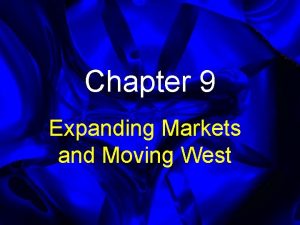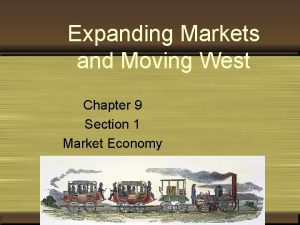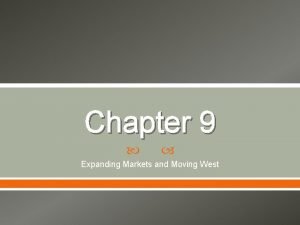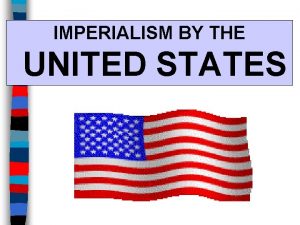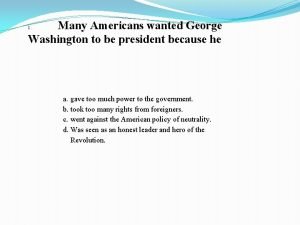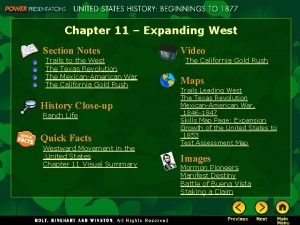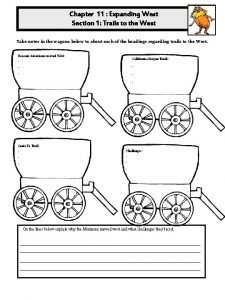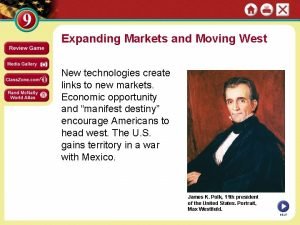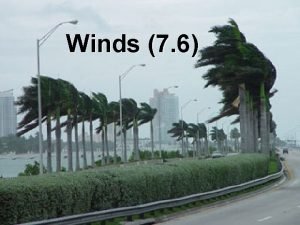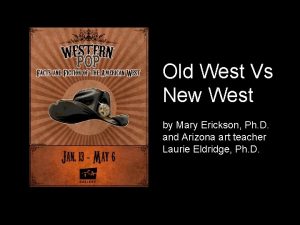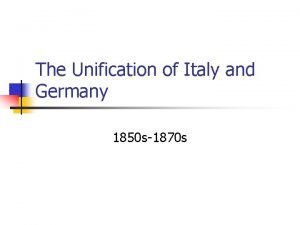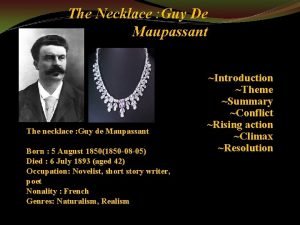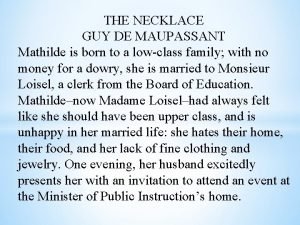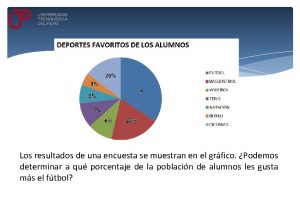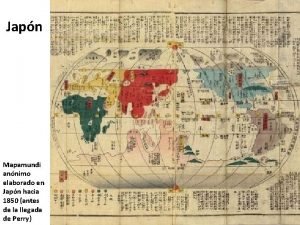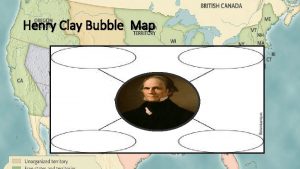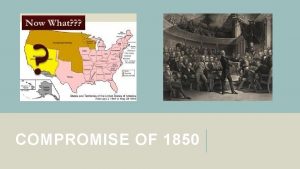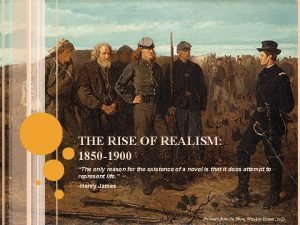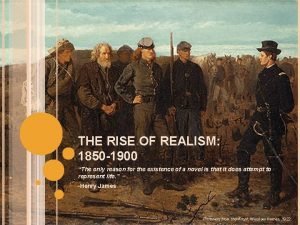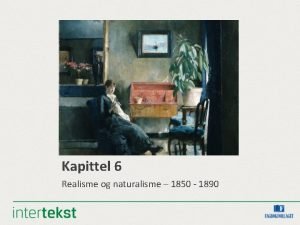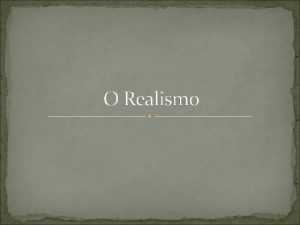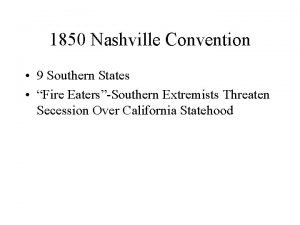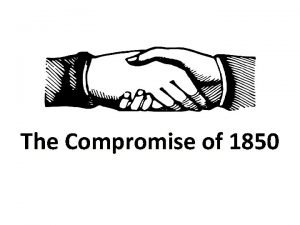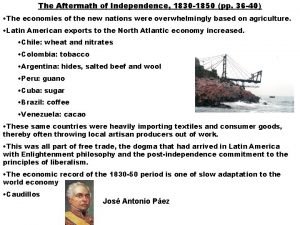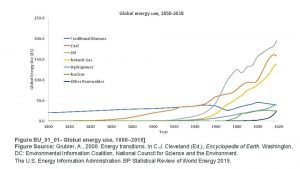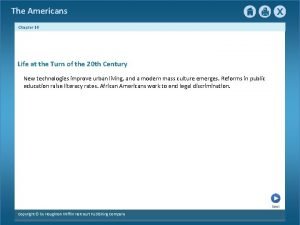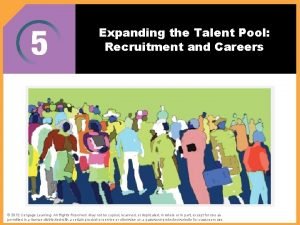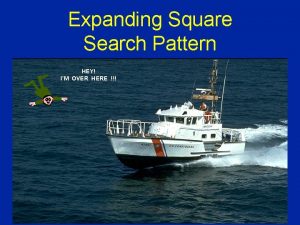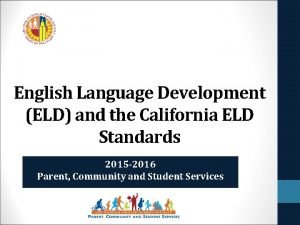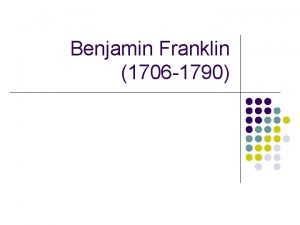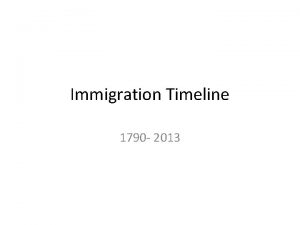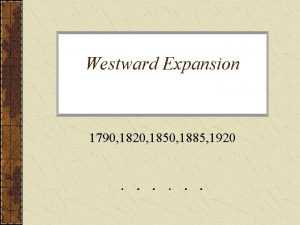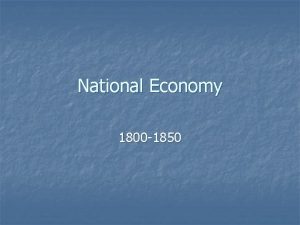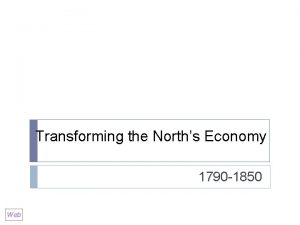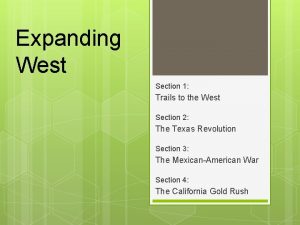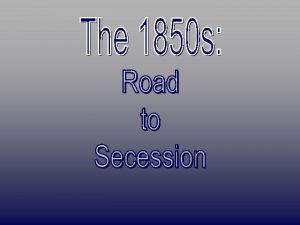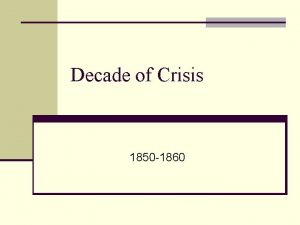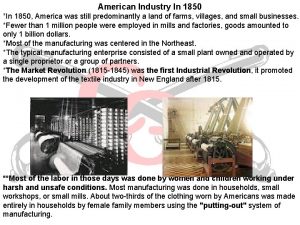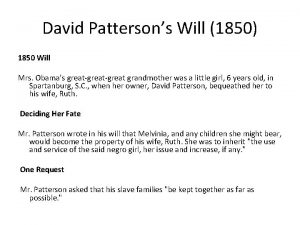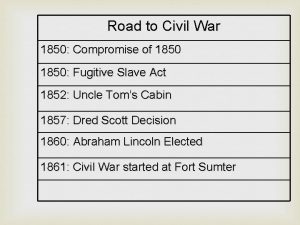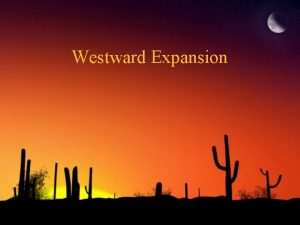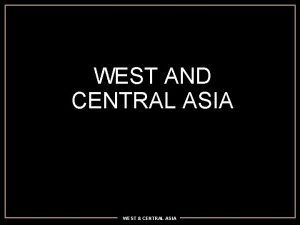Chapter 16 Expanding West 1790 1850 Chapter 16













































- Slides: 45

Chapter 16 Expanding West (1790 -1850)

Chapter 16 Expanding West (1790 -1850) Section 1 The Spanish West and Southwest

Life in Northern New Spain • New Spain’s northern frontier was made up of California, New Mexico, and Texas – New Mexico = oldest; capital = Santa Fe • Spanish colonists and Pueblo Indians influenced one another in New Mexico’s small, scattered villages – Spanish changed many aspects of Pueblo life – brought new tools and new foods to region – Spanish introduced to beans and corn; began to build adobes

Life in Northern New Spain • Life in California different from life in New Mexico – Missions = center of life; between 1769 -1823, 21 missions built – Spanish military forts (presidios) protected missions • Hoped military presence would keep British and Russians out of region • Missions held great deal of land – used for farming and ranching – American Indians performed most of the labor • Missions supported themselves selling goods to local communities • Spanish colonists in California known as Californios – cut off from rest of New Spain because of distance

Early Texas • Spain built up to 40 missions in Texas – Weaker than the mission system in California – Texas missions further apart and they often fought with local American Indians (Apache and Comanche) • Fewer Spanish settlers moved to Texas (Tejanos)

Early Texas • Spanish government offered land grants to settlers – By mid-1700 s only a few thousand Tejanos lived in Texas • Introduced new breeds of cattle and soon created cattle-ranching society • Comanche and Apache still controlled much of Texas, limited Spanish expansion

Mexico Gains Independence • 1810 – 80, 000 poor American Indians and Mestizos in Mexico joined in revolt against Spanish rule – Led by Father Miguel Hidalgo y Costilla (Mexican priest) • Rebels hoped independence would improve living conditions • As Father Hidalgo marched army across countryside he began reforms such as ending enslavement and unfair taxation of American Indians

Mexico Gains Independence • Hidalgo could not unite all Mexican villages; Spanish defeated rebels, killed the priest • Father José María Morelos y Pavón continued revolution and Hidalgos reforms; fought bravely until captured in 1815 • Agustín de Iturbide – led rebels to defeat Spanish in 1821 – Made himself Mexico’s emperor; stepped down after 1½ years • New congress created a new constitution (1824) – made Mexico a republic – Country included what is now Arizona, California, Nevada, New Mexico, Texas and Utah – Contained parts of Colorado, Kansas, Oklahoma and Wyoming

Changes in California and Texas • 1833 Mexico ended Spanish mission system in California and gave mission lands to Californios – Group of about 500 families created large ranches – largest had up to 90, 000 acres – For most American Indians, life did not greatly improve with end of mission system • Texas merged with Mexican province of Coahuila to form Coahuila y Texas • Many Tejanos were chased away or killed during war – Mexican officials worried so few people could not protect all of Texas • Government decided to recruit more settlers to protect northern frontier from American Indian attacks or possible invasion

Chapter 16 Expanding West (1790 -1850) Section 2 Texas Gains Independence

American Settlers in Texas • Empresarios, or agents, were hired by Mexico to bring settlers to Texas – Received land – as much as 67, 000 acres for every 200 families • Stephen Austin selected colony on the lower Colorado River – First 300 settlers became known as “Old Three Hundred” – He worked to keep the peace between the Mexican government and American settlers • Most American settlers came from southern states – Attracted by promise of free or cheap land

Trouble in Texas • Mexico set requirements foreign immigrants (1821) – Had to become Mexican citizen, obey Mexican laws, and support the Roman Catholic Church • Most U. S. settlers not interested in adapting to Mexican culture or becoming Mexican citizens • By 1830, there were more American settlers than Tejanos – Ignored Mexican laws, acted as though still in U. S. – Many went to Texas illegally, felt little loyalty to Mexico

Trouble in Texas • Americans and Tejanos argued they were not fairly represented in Mexican government – Mexican central government too powerful; called for Constitution of 1824 to be more strictly followed • Mexico responded by enforcing laws more strictly – Worked to keep settlers from bringing in slaves – Tariffs on goods from U. S. raised – Sent more soldiers to Texas

Trouble in Texas (continued) • Austin tried to keep peace; went to Mexico with petition asking for more self-government (1833); thrown in jail • General Antonio López de Santa Anna elected president of Mexico (1833) – Suspended constitution in 1834 • Austin released from jail after 1 ½ years, called for all Texans to rebel

The Texas Revolution Begins • Started in the town of Gonzales when Mexican army tried to remove a cannon located there – Texans defeated Mexican soldiers after brief battle • Nov. 1835 – group of Texans formed a temporary government – Goals – defeating Santa Anna and restoring Mexican Constitution • Texas volunteers captured the towns of Goliad and San Antonio

The Texas Revolution Begins • Texans occupied the Alamo – led by William Travis, Jim Bowie, Davy Crockett • Santa Anna led 1800 troops to San Antonio to put down rebellion – Travis refused to retreat – Santa Anna arrived February 23, 1836, Travis only had 189 troops – Mexicans surrounded the Alamo for 13 days; attacked and overpowered Texans – all defenders of the Alamo killed

The Texas Revolution Begins (continued) • “Remember the Alamo!” became the rallying cry in Texas and the U. S. because survivors like Susanna Dickinson and others spread the story of the Alamo • Mexican forces attacked troops near town of Goliad – Texans outnumbered – Texas Commander James Fannin chose to surrender – Santa Anna executed Commander Fannin and some troops

Texas Becomes a Republic • Texas delegates met to declare their independence from Mexico four days before the Battle of the Alamo – Texas Declaration of Independence and Constitution were modeled on U. S. – Texas Constitution specifically made slavery legal – David Burnet – temporary president; Lorenzo de Zavala

Texas Becomes a Republic • Sam Houston became commander in chief of Texas army – Outnumbered and untrained his soldiers had to retreat east • Battle of San Jacinto (near present-day Houston) – Houston’s army launched surprise attack – “Remember the Alamo! Remember Goliad!” – Santa Anna’s troops drive back and trapped in nearby woods • Santa Anna captured and forced to sign treaty giving Texas independence (1844) – Many Mexican officials did not accept Texas as being independent

Chapter 16 Expanding West (1790 -1850) Section 3 The Lone Star Republic

Texas Faces the World • Republic of Texas – independent nation of Texas – Capital – Houston – Sam Houston elected president (former governor of Tennessee); Mirabeau Lamar – VP • New government asked the U. S. to annex Texas in 1837 – Members of Congress wanted to annex but President Jackson (and later President Van Buren) was concerned because Texas supported slavery • Also, Jackson did not want to go to war with Mexico

Texas Faces the World • U. S. recognized Texas as independent nation; France did in 1839, Great Britain in 1840 – Mexico still refused to agree that Texas had become independent

American Indians and Tejanos • Houston established peaceful relations with American Indians • Indian policy changed (became more harsh) in 1838 when Mirabeau Lamar became president – Demanded American Indians leave homelands and follow all Texas laws – threatened military action if they refused • Fighting broke out with the Cherokee and Comanche – Raids increased – Texans believed Cherokee were plotting with Mexico to overthrow the republic

American Indians and Tejanos • Houston elected to 2 nd term (1841), fighting slowed – Texans had already forced most American Indians from their eastern lands • Relations with Americans and Tejanos suffered in New Republic – Tejanos often faced unfair treatment – lost land, political power and property

New Immigrants • TX offered land grants to American and European settlers to increase population – 1840 -1841 – gave out nearly 37 million acres • Largest group of immigrants to TX was from U. S. – In search of land, economic opportunities, particularly after Panic of 1837 – Majority from southern states; most small farmers, did not own slaves • Slaveholders attracted because TX constitution made slavery legal – Population of enslaved African Americans increased from 5000 (1836) to 70, 000(1845)

New Immigrants • Laws of republic made life former slaves difficult – Free African Americans banned from immigrating to TX – Free African Americans living within TX would have to leave within 2 years or be sold into slavery • Germans made up largest group of European immigrants to TX – Laws had to published in German and English (1843) – Established farming communities • French, Irish, Czech, and Polish also immigrated

Struggles of the Republic • Small, scattered population; faced challenges as any independent country would • Only 4 TX towns had population greater than 1000 – Galveston, Houston, New Braunfels, San Antonio • Travel between newer settlements was slow, difficult and often dangerous • Significant economic problems – Economy based largely on farming and ranching – Had little cash; new nation was almost bankrupt • Taxes on imports and property failed to bring in much revenue

Struggles of the Republic • Government’s lack of funds made it difficult for TX to defend vast territory – Houston forced to disband most of TX army due to discipline problems – Relied on militia companies and Texas Rangers for defense and frontier protection

Struggles of the Republic • Mexico still considered TX to be its property • 1841 – Lamar authorized military attack on Santa Fe in Mexican territory of New Mexico – Invasion lacked approval of Texas Congress and failed – Mexican army took control of San Antonio on 2 occasions • Peace treaty signed in 1844 after Houston returned to presidency

Chapter 16 Expanding West (1790 -1850) Section 4 Oregon and the Far West

The Fur Traders • First non-American Indians who traveled to Rocky Mountains and Pacific Northwest were fur traders and trappers a/k/a mountain men • American Fur Company = one of the largest businesses that bought furs from trappers; owned by John Jacob Astor

The Fur Traders • Mountain men adopted American Indian Customs and clothing to survive; often married American Indian women • Bringing furs out of Rocky Mountains = expensive – Traders often stayed in mountains, met once a year to trade and socialize = rendezvous • Filled with celebrating, storytelling; conducting business • Era of American fur trading in Pacific Northwest lasted a short time – Demand for beaver furs fell as fashions changed – Too much trapping lowered supply – Some trappers moved back east; others began guiding farmers, miners and ranchers to the west

Oregon Country • 1811 – John Jacob Astor founded Astoria as center for fur trade at the mouth of the Columbia River (Pacific northwest) – Small outpost = one of the earliest American settlements in the region later called Oregon Country) • Beginning of 1800 s – Oregon Country occupied by American Indians

Oregon Country • Great Britain, Russia, Spain and U. S. claimed the region – U. S. claim based on exploration of merchant captain Robert Gray (1792) • Adams-Onis Treaty – Spain gave up claims to land beyond the northern border of what is now California • Russia signed a treaty with U. S. – gave up claims to southern border of what is now Alaska • U. S. and Britain signed treaty in 1818 allowing both to occupy Oregon Country – Extended treaty in 1827 – did not state how long shared ownership would last

The Missionary Spirit • Missionaries were among first Americans to settle Oregon Country – Some churches wanted to bring Christianity to American Indians in Far West during 2 nd Great Awakening • Marcus and Narcissa Whitman – missionaries – Settled in Walla – present-day Washington state – Founded a mission called Waiilatpu – Limited success – Efforts ended in tragedy – killed by angry American Indians after epidemic killed many children

A New Life Out West • Thousands from the Midwest moved to Oregon Country looking to improve their lives – Newspapers encouraged movement; reported rich farmland, great forests, rivers full of fish, good climate • New territorial government set up in 1843 set up system of land grants to attract more settlers • Most new settlers moved into the Willamette Valley – Majority stayed and prospered in what is now Oregon – Others settled in what is now Washington • Population growth led to increased conflict with American Indians and greater tension with Great Britain

The Oregon Trail • Many settlers moving to Oregon followed the Oregon Trail – Stretched more than 2, 000 miles across the northern Great Plains and the Rocky Mountains

The Oregon Trail • Started journey in Independence or St. Joseph, Missouri or Council Bluffs, Iowa • Lasted about 6 months • Gathered in wagon trains • Shortages of food, supplies and water were a constant problem • Faced weather and natural barriers

Opening the American West

Chapter 16 Expanding West (1790 -1850) Section 5 California and the Southwest

Going to California • 1830 s and 1840 s California still under Mexican rule • Main route to California started with Oregon Trail – California Trail ran through the Sierra Nevada mountains – tried to cross before first snow • Donner party – western travelers with bad luck and poor judgment – Began journey west in spring of 1846 – Left main trail and got lost looking for shortcut – Trapped in heavy snow when they reached the Sierra Nevada – When rescue party found them, 42 of the 87 had died

Going to California • California became a meeting ground for merchants from Mexico and the U. S. • Mexicans and American Indians made up most of California’s population • Mexico gave Swiss immigrant John Sutter permission to start a colony in 1839 – Sutter’s Fort was located near the Sacramento River and became a popular rest stop for American immigrants

Other Southwestern Trails • After Mexico gained its independence in 1821, the Mexican government agreed to allow American merchants to come to New Mexico – Seized opportunity by starting the Santa Fe Trail – ran from Independence, Missouri to Santa Fe, New Mexico – Loaded wagons with cloth and other manufactured goods to exchange for horses, mules and silver • U. S. government offered traders protection by sending troops and providing money to ensure American Indian cooperation


Frontier Artists • Artists inspired to travel west with explorers to the frontier • George Catlin gave up career as portrait painter in Philadelphia to go west – Painted more than 500 images of American Indians • Alfred Jacob Miller traveled through the Rocky Mountains painting the landscape
 Chapter 9 expanding markets and moving west
Chapter 9 expanding markets and moving west Chapter 9 expanding markets and moving west
Chapter 9 expanding markets and moving west Chapter 9 expanding markets and moving west
Chapter 9 expanding markets and moving west 1790 foreign policy
1790 foreign policy Us map 1790
Us map 1790 Coquille meaning
Coquille meaning Americans wanted george washington to be president because
Americans wanted george washington to be president because Expanding west section 2
Expanding west section 2 Expanding west section 3
Expanding west section 3 Expanding markets and moving west
Expanding markets and moving west Horizontal movement of air is called
Horizontal movement of air is called Name of the wind series
Name of the wind series Zuid oost noord west
Zuid oost noord west East is east and west is west
East is east and west is west Old west vs new west
Old west vs new west Where was prussia in 1850
Where was prussia in 1850 The necklace lesson learned
The necklace lesson learned Into which family was mathilde born
Into which family was mathilde born The necklace by guy de maupassant (1850 to 1893)
The necklace by guy de maupassant (1850 to 1893) Adrien marie legendre
Adrien marie legendre Lei de terras 1850
Lei de terras 1850 Neoclassicism (1750–1850)
Neoclassicism (1750–1850) Dos depositos contienen 2587 y 1850
Dos depositos contienen 2587 y 1850 Mapamundi 1850
Mapamundi 1850 Explain the compromise of 1850
Explain the compromise of 1850 Scoperte scientifiche dal 1850 al 1900
Scoperte scientifiche dal 1850 al 1900 Who created the compromise of 1850? *
Who created the compromise of 1850? * A 1850 kg luxury sedan stopped
A 1850 kg luxury sedan stopped Realism 1850 to 1900
Realism 1850 to 1900 Realism 1850 to 1900
Realism 1850 to 1900 Albertine et dukkehjem
Albertine et dukkehjem Entre 1850 e 1900 surge nas artes europeias
Entre 1850 e 1900 surge nas artes europeias Nashville convention 1850
Nashville convention 1850 Compromise of 1850
Compromise of 1850 1850*36
1850*36 Compromise of 1850
Compromise of 1850 Marat artist
Marat artist Compromise of 1850
Compromise of 1850 Billions8
Billions8 Chapter 16 section 1 science and urban life
Chapter 16 section 1 science and urban life Win win plinske peci
Win win plinske peci Identify a warning sign of a weak talent bench.
Identify a warning sign of a weak talent bench. Expanding square search pattern
Expanding square search pattern Expanding double brackets worksheet
Expanding double brackets worksheet Bridging emerging expanding
Bridging emerging expanding Expanding brackets grid method
Expanding brackets grid method
